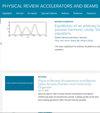定量单次射击和空间分辨等离子体尾流场诊断
Physical Review Special Topics-accelerators and Beams
Pub Date : 2015-08-06
DOI:10.1103/PHYSREVSTAB.18.081302
引用次数: 6
摘要
等离子体状态的诊断对等离子体尾流场加速器实验的优化具有很大的优势。一种可能的方法是光子加速。通过将激光探针脉冲穿过等离子体尾流场并提取所施加的频率调制,可以得到尾流场密度调制的图像。为了诊断等离子体中选定点的尾流场参数,探针脉冲以相对于尾流场的斜角度穿过等离子体。本文导出了激光脉冲频率调制与等离子体斜交角尾流场密度分布的数学表达式。本文的多维细胞内粒子模拟结果证实了频率调制曲线和密度调制曲线的一致性在10%以内。本文讨论了测量精度的限制。该技术为定量诊断等离子体柱内已知位置的等离子体尾流场密度开辟了新的可能性。本文章由计算机程序翻译,如有差异,请以英文原文为准。
Quantitative single shot and spatially resolved plasma wakefield diagnostics
Diagnosing plasma conditions can give great advantages in optimizing plasma wakefield accelerator experiments. One possible method is that of photon acceleration. By propagating a laser probe pulse through a plasma wakefield and extracting the imposed frequency modulation, one can obtain an image of the density modulation of the wakefield. In order to diagnose the wakefield parameters at a chosen point in the plasma, the probe pulse crosses the plasma at oblique angles relative to the wakefield. In this paper, mathematical expressions relating the frequency modulation of the laser pulse and the wakefield density profile of the plasma for oblique crossing angles are derived. Multidimensional particle-in-cell simulation results presented in this paper confirm that the frequency modulation profiles and the density modulation profiles agree to within 10%. Limitations to the accuracy of the measurement are discussed in this paper. This technique opens new possibilities to quantitatively diagnose the plasma wakefield density at known positions within the plasma column.
求助全文
通过发布文献求助,成功后即可免费获取论文全文。
去求助
来源期刊
自引率
0.00%
发文量
0
审稿时长
3-8 weeks
期刊介绍:
Physical Review Special Topics - Accelerators and Beams (PRST-AB), is a peer reviewed, purely electronic journal, distributed without charge to readers and funded by contributions from national laboratories. It covers the full range of accelerator science and technology: subsystem and component technologies, beam dynamics; accelerator applications; and design, operation, and improvement of accelerators used in science and industry. This includes accelerators for high-energy and nuclear physics, synchrotron radiation production, spallation neutron sources, medical therapy, and intense beam applications.

 求助内容:
求助内容: 应助结果提醒方式:
应助结果提醒方式:


